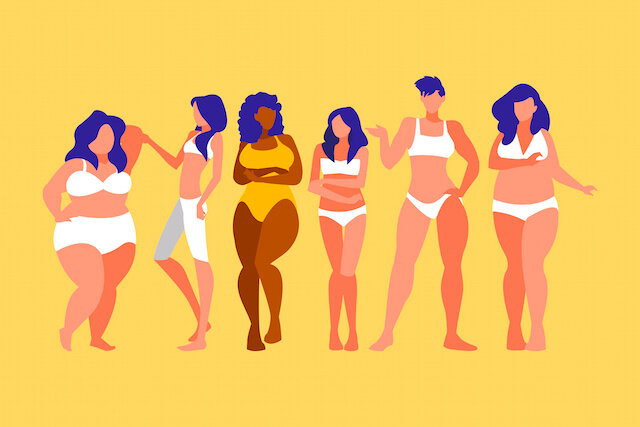Believing The "Perfect Body" is You
With the rise of social media over the past several years, the frequency at which people are seeing images of the ‘perfect body’ has increased, which has had a negative impact on many people’s feelings about body image. Many men and women find themselves constantly comparing their bodies to those of reality stars and social media influencers, leading them to struggle with accepting how they actually look. This inevitably leads to low self-esteem and both mental and psychological disorders. The abundance of social media and the constant pressure to look a certain way, has led so our generation to tragically believe that who we are is not accepted or not enough.
The ideal body type for most women, highlighted by the media, is the slim, feminine figure that is typically recognized as the ‘model’ body type. In order to achieve this standard, many women want toned abs, arms, and legs, as well as defined curves to accentuate their femininity which society deems vital. Model and reality star Kendall Jenner is a prime example of this nearly unattainable standard that has taken up a significant space in the minds of women and young girls all around the globe. Body ‘trends’ fluctuate overtime, but the ideation of an hourglass figure is something that our society keeps coming back to. However, Marilyn Monroe had a very different body type to today's current influencers such as Gigi Hadid, Kaia Gerber, Adut Aekch, or Naomi Campbell. It seems that the ideal figure continuously moves further out of reach. Additionally, some might argue that insecurities are far more widespread today. In the past, social media wasn’t around to play a role in the image of the ‘perfect’ body. Pre-social media, these standards were spread by magazines, television shows, movies and ads, which were far less invasive than applications such as Instagram. With how often many use social media, it is almost impossible now to avoid these often unattainable beauty standards. Wherever you look, women are constantly reminded that society identifies beauty based on size and this causes the misconception that women are valued more for their bodies than their intelligence or personalities.
Sizing has become a bigger issue as well. Many women struggle to accept their beauty if they do not fit in certain “acceptable” sizes, such as a size 0 waist and with prominent curves. Along with the media, clothing brands have added to the misconception that there is such a thing as a ‘perfect body.’ Many brands cater especially to these body types with tight tops and small waist sizes to accentuate these specific points on the female body which are societally seen as beautiful. Additionally, some brands such as Brandy Melville only carry one size, supporting the notion that ‘one size fits all’. Not only is this advertisement inconsiderate, but it also leads women who do not fit in that one size to believe that they cannot be included in fashion, or that they cannot wear what others wear. In contrast, many influencers have taken to the media in order to promote ‘plus size’ bodies in an attempt to show that all bodies are normal and beautiful. Though the effort is there, many of these young men and women are not in fact plus size, leaving many people thinking that their physical appearance does not fit in anywhere.
In a study done on female body shape preferences in 2017, men from 10 different countries were asked to rank body shapes by attractiveness. It was revealed that many preferred a body type with a BMI of 19. This is borderline underweight. It was also found that there was an obvious correlation in the men's preferences between a higher BMI and a lower level of perceived attractiveness. The misconception that skinny is the only beautiful body type can cause many long-term mental and physical disorders. Anorexia is one of the most prevalent eating disorders among men and women in America, and many cases, both mild and severe, are perpetuated by the media and the pressure to fit this limiting criteria. What many people fail to realize aside from the fact that many influencers have had work done, is that every body type is very different. This means that even through a rigorous workout regime and strict diet, the figures of these models are often unachievable simply because of genetic makeup. Further proving that these influencers should not be seen as the ‘normal’ body type.
Rather than promoting realistic images, the media continuously highlights those that are often unattainable to the vast majority. This has been improving somewhat due to the backlash from members of younger generations who are sick of these ridiculous standards. These issues of how we see ourselves and how we feel about it are difficult to battle. Comparing yourself to anyone else, whether it be models, social media influencers, or even friends is never the answer. Though difficult to combat, comparison and discontentment in your own body can be the roots from which far more concerning issues can stem. Everybody and every body is beautiful. It is our imperfections that make us exquisite and unique, and we all need to put more effort into understanding that. Building confidence is never an easy feat, but it starts with self-love and appreciation for every ‘flaw’ and aspect that truly makes you you.
By Sydney Feld

